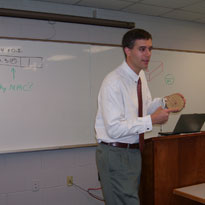Statistical Process Control
- Course:Statistical Process Control
- Course ID:SPCON Duration:3 days Where: Your Office (7+ Persons)
- Download Course Description (PDF)
Available as a private, customized course for your group at your offices or ours and in some cases as a WebLive(TM) class.
Course Outline
Day 1: Course Overview and Introductory Concepts
- Course Overview
- Course outline
- Introductions
- The Industrial Revolution
- Mass production
- Division of labor
- Taylorism
- Typical engineering drawing and specification practices
- Engineering tolerances historical contexts
- Typical engineering drawing tolerance responsibilities
- Manufacturing Processes
- Process capabilities
- Process capability versus engineering tolerances
- Deterministic versus Probabilistic Thinking
- Typical test and inspection approaches
- Typical build-and-inspect approaches
- The psychology of inspection
- Product quality responsibilities
- The sampling approach and its pitfalls
- Detection versus prevention management philosophies
- Driving blindfolded
- Introduction to Statistics and Probability
- The nature of variability
- Shewhart’s formative work
- Frequency distributions
- Histograms
- The normal curve, means, and standard deviations
- Normal curve mathematics
- Averages of averages and the central limit theorem
- Statistical Process Control
- SPC overview
- SPC basic concepts
- SPC control in World War II
- The US rejection of SPC after World II
- Japan’s SPC acceptance after World War II
- SPC success stories
- Placing product quality responsibility in the operator’s hands
- Statistical Process Control Concepts
- Inspection shortfalls
- Attributes versus variables data
- Placing quality responsibility in the hands of the operator
- xbar:r charts
- SPC capabilities
- Class exercise
Day 2: SPC Implementation
- Training
- Management training
- Supervisor training
- Operator training
- Selecting Processes for SPC application
- Variables data opportunities
- Optimizing early successes
- Defining the process
- Flowcharting
- Assessing existing test and inspection points
- Selecting critical characteristics for SPC application
- Identifying critical dimensions
- Identifying sources of variability
- Ishikawa charts
- Minimizing variability
- Case study
- Class exercises
- Gathering SPC Preliminary Data
- Collecting data for establishing upper and lower control limits
- Calculating upper and lower control limits
- Defining subgroups and calculating averages
- Class exercise
- Preparing, Maintaining, and Using Charts
- xbar:r charts
- Typical xbar:r charts required information
- Collecting individual data points
- Calculating average values
- Finding the range
- Defining nominal and upper and lower control limits
- Plotting averages, ranges, and the grand average
- Finding the standard deviation
- Using Excel to simplify xbar:r calculations
- Finding the average range
- Finding upper and lower control limits for the range
- Simplified approaches for determining upper and lower control limits
- Class exercises
- p-Charts
- Attributes data applicability
- Converting attributes data to variables data
- The nature of p
- Finding the average p
- Finding p upper and lower control limits
- Using the average p and upper and lower control limits to create a p chart
- Class exercises
Day 3: Putting SPC To Work For Your Organization
- Using SPC Charts
- Plotting process data on SPC charts
- Noting process changes
- Identifying trends
- Shifting responsibility to the operator
- Class exercise
- SPC Trend Analysis
- No trend
- Subgroup averages trending upward or downward
- Multiple points above or below the average
- Cyclical patterns
- Range changes
- Calling for help when trends are recognized
- Class exercise
- SPC Implementation Challenges
- Resistance to change
- Inspector job security
- Seeking input from affected personnel
- Selecting initial SPC-implementation points
- Maintaining momentum
- Publicizing success
- Course Review and Wrap-Up
- Wrap-up.
- A suggested Statistical Process Control implementation roadmap.
- Course critique.
Course in a Nutshell
This is a comprehensive and intensive 3-day course that presents the essential elements of an effective Statistical Process Control program. The course focuses on understanding the basics, identifying objectives, SPC implementation, and realizing the benefits this magnificent process management system offers. The course develops and presents a results-oriented roadmap for implementing an effective Statistical Process Control program.
Customize It!
Whatever the nature of your system and industry, we will customize the course to meet your specific needs and concerns. Here are some of the ways in which we can tailor the course to help you get more out of it:
- Add a “workshop day” to the course to allow the participants to work together to analyze Statistical Process Control issues specific to your organization. The workshop day can be scheduled a few weeks after the course to allow time for applying the technologies presented in class under an experienced practitioner’s guidance.
- Schedule post-class follow-up consultation for ongoing Statistical Process Control program improvement.
Learn How To
- Develop an effective Statistical Process Control system.
- Objectively identify Statistical Process Control opportunities.
- Work together to implement and improve your Statistical Process Control program.
Aimed At
This course is aimed at supervisors, managers, purchasing personnel, manufacturing engineers, quality engineers, program managers, and others responsible for product quality improvement, variability reduction, and cost reduction.
Prerequisites
The course assumes a process, industrial, manufacturing, inspection, quality assurance, or engineering background.

